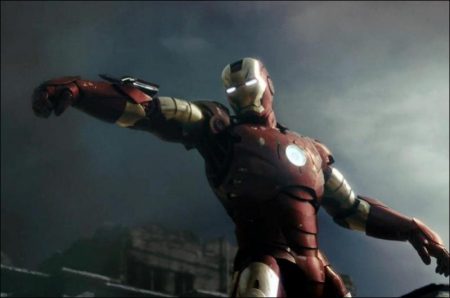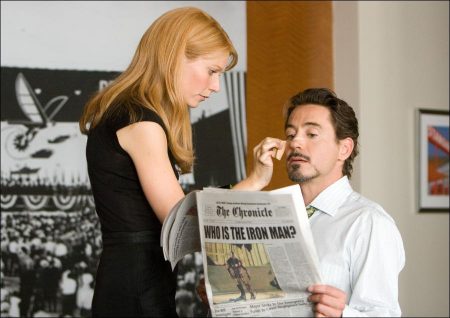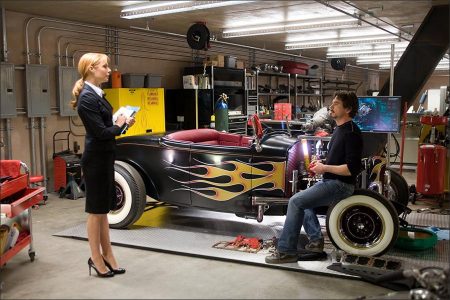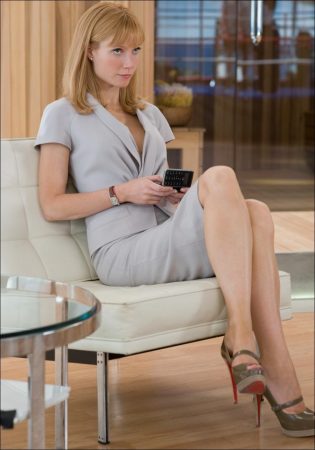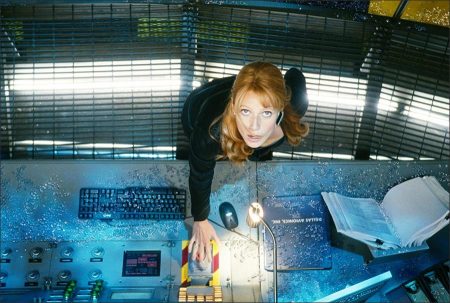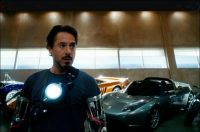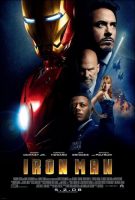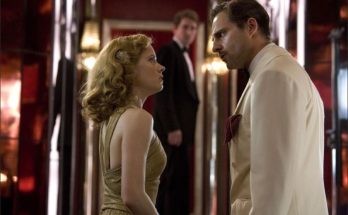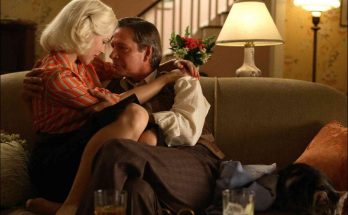All About Iron Man
With casting completed, the filmmakers made the decision to set the film in Los Angeles. With key locations that included Edwards Air Force Base, historic “Movie Road” in Lone Pine, CA and the Playa Vista Stages, director Jon Favreau explains his decision to make Iron Man a West Coast superhero.
“’Iron Man’ is an adventure that takes you around the globe,” says Favreau. “The character of Tony Stark is a guy who’s involved in the whole geo-political landscape, which really opened up our world. I wanted to set this film on the West Coast even though the Iron Man comic is traditionally set in New York, as are all the Marvel superhero comics. I wanted a different look, so instead of having Iron Man flying between New York City buildings, we have the ocean and mountains of the West Coast in the film. I also felt shooting in Los Angeles tied in with the roots of the whole Howard Hughes influence and the history-of-flight aspect.”
Principal photography began at the Playa Vista Stages in Playa Vista, California, on the west side of Los Angeles. The stages would serve as home base for the production, with a majority of the film shot on two stages whose history can be directly linked to Howard Hughes.
“When we were looking for stages in Los Angeles that would be large enough for all the sets we had to build, we turned to the Playa Vista Stages,” recalls Favreau. “We thought it was really cool because it was Howard Hughes’ old assembly factory and the place where the wings for the Spruce Goose were originally built.”
“When you make movies, they take on a sort of mythic life of their own,” adds executive producer Billingsley. “It’s no coincidence that our sound stages are the two hangars where Howard Hughes worked. Hughes originally inspired Stan Lee when he was creating Tony Stark, and in this film the character is a real blend of wealth, genius and fame.”
The first sequences shot on the stages took place in the cave set where Tony Stark is held captive and forced to build his company’s Jericho missile for Raza, the leader of a group of insurgents in the Middle East. Tony, against the advice of his fellow captive Yinsen, begins to build what will become the first suit of armor he wears in the film. Following his director’s mantra of keeping the film as authentic as possible, J. Michael Riva, who designed the production, was faced with the challenge of creating a set that looked and felt like a rugged cave in the mountains of Afghanistan.
“The really fun part about building the cave was dressing the set,” explains Riva. “When you’re locked up in a place for two or three months by terrorists, presuming that you’re not being ‘water-boarded’ the big question becomes `how do you live? What’s the daily routine’? Now Robert, who has had some first-hand knowledge of what it’s like to be held captive, brought some of his own very revealing ideas to the cave dressing that made our job easier and gave it an authenticity – things like how to make tea with a sock and how you make a backgammon set out of nothing. We lived in the cave overnight before we started shooting to really feel it out.”
Riva continues: “One of the things I discovered in my research of truly remote caves is how cold they really are. I saw some footage of a cave interior in Tora Bora, Afghanistan. In it, a Taliban fighter is being interviewed and you can see his breath. So I convinced Jon Favreau we should `freeze’ the set. We built an air conditioning system into the cave and had cold air coming out of the actors’ mouths for days – something everybody hates me for to this day – but it was very effective and really showed the harsh contrast of being held captive – especially for a billionaire like Tony Stark. Robert and the rest of the cast loved it. And so did Jon.”
The Suit(s)
While the production was shooting the cave sequences, four-time Academy Award winner Stan Winston and his team of makeup and special effects artists were busy building all the armor Iron Man wears in the film.
“I worked with all the folks at Stan Winston Studios on `Zathura’ and have been a fan of their work for a really long time,” says Favreau. “They’ve always been a wonderful collaborative group. It was a great opportunity to introduce Marvel to a whole new group of suit designers, and I was thrilled to be able to get Stan and his gang involved in a new movie franchise.”
“The minute we heard that `Iron Man’ was being made, we really went after it,” admits Winston. “I’m a big comic book fan and Jon Favreau really understands the concept of how to mix all the different technologies and do whatever it takes to make things work, rather than getting caught up in doing a movie that relies heavily on digital effects. The final design of these suits is quite amazing and I am confidant that it will be some of the coolest stuff this studio has ever produced.”
Prior to Stan Winston Studios beginning construction, Favreau describes the concept and design process that went into the creation of the different suits of armor. “When I was first hired on to direct `Iron Man,’ the images I gravitated to were the Adi Granov illustrations and paintings from the recent ‘Extremis’ series of Iron Man comic books. That one felt the most grounded in technology and was also the most dynamic. As we started to talk about design elements, Adi actually contacted me because he saw that I posted a lot of his images on the ‘Iron Man’ MySpace page I had set up. We started corresponding via e-mail, and he later flew to Los Angeles to help oversee the design process of the suits. I also brought in illustrator Phil Saunders and conceptual designer Ryan Meinerding, who were both very valuable in helping us refine the different versions of the `Iron Man’ suit.”
In the film, the first suit Tony Stark builds during his captivity is the Mark 1 armor. Originally called the “Grey Armor” in the early years of the Marvel comic, Favreau speaks about the process the filmmakers came up with for the suit’s concept design. “I never fully believed that this suit could have been built in captivity, especially under the watchful eye of hostile captors. Conceptual designer Ryan Meinerding came up with the idea of building the suit out of materials that could have been scavenged from other Stark Industry weapons. He was able to conceptually imagine a suit that looked like a bit of a junkyard war weapon creation. It’s probably my favorite suit in the whole movie and most original in our film.”
“Ryan is one of the best conceptual designers in the business,” adds Phil Saunders. “He did an amazing job of taking that iconic, sci-fi design of the very clean, boiler plate metal and making it something that really felt like it was made out of spare military parts and surplus equipment. You may notice that some of the back panels on the suit are less armored than the front. That really came from Tony’s idea that `I need to get through this gauntlet of people by moving forward and there’s not going to be anyone behind me because I’m gonna be toasting everybody in my path.’ So there really was a psychological concept that went into the armor for the character and how he put those pieces together.”
The responsibility of physically building the Mark 1 suit, as well as all the other suits in the film, fell squarely on the shoulders of Shane Mahan, suit effects supervisor at Stan Winston Studios. An employee at Winston’s for over 25 years, Mahan describes the process of building the Mark 1 armor. “First of all, the designs provided to us for the Mark 1 were very strong. The concept was hunks of metal, parts of bombs, a complete hodgepodge of pieces. It was really a lot of fun to build, because it served two functions: it paid homage to the original comic book, and it also showed the evolution of Iron Man. We built the suit with the mindset of it being an escape suit that is like a powered human tank around his body.”
Mahan continues, “We also had to make the suit as light as possible without compromising its integrity, because we knew that we wanted to make sure that Robert and the stuntmen who were going to wear the suit and move around in it didn’t look awkward. The suit ended up weighing about 90 pounds because we had to make the internal structure sound enough so that it could withstand some hits without being crushed. We also constructed it to be worn in pieces so that Robert or a stuntman could wear the top half of the suit without the legs, which made it easier on the performers.”
The sturdiness of Mahan’s Mark 1 suit was unexpectedly put to the test early on when stuntman Mike Justice tipped over in the full suit and fell to the ground after shooting a take in the cave.
“When I saw Mike fall face-first to the ground, my heart jumped out of my chest,” recalls Mahan. “My first thought was, `Oh no, I hope Mike is alright,’ quickly followed by, `Oh no, I hope the suit is still in working order.’ We only had one Mark 1 suit so anything that happened to it would have to be repaired on the actual suit. Luckily for us, Mike was fine and the suit was not damaged and we continued shooting.”
For stuntman Mike Justice, falling to the ground wearing the 90-pound suit was all in a day’s work. “The one thing you did not want to do is fall over in the Mark 1 suit because it was the heaviest and had a lot of components that could be damaged,” says Justice. “The biggest challenge with that suit was that you had very limited peripheral vision and could only see the ground directly in front of you. I was lucky when I tripped and fell over in that I resisted the natural instinct to put my arms out, or I probably would have broken my wrists. They just picked me up, dusted me off and we went back to work.”
For Downey, the first time he worked in the Mark 1 brought a newfound respect for his team of stuntmen. “I’d been training all these years and thought I was pretty tough, but the first time I put on the Mark 1 suit, I almost had a personality meltdown,” laughs Downey. “I’m not claustrophobic, but after moving around in it for a couple of hours your spirit is kind of broken and you’re like, `ok, time to bring in the stunt team.’”
On Location
With the Mark 1 suit completing its successful debut in the cave sequences, the production moved north to Lone Pine, California to shoot the film’s ambush scenes, where Tony Stark’s convoy is attacked by a group of insurgents following his company’s demonstration of its newest weapon, the Jericho missile. The convoy attack sequence finds Downey running through a flurry of explosions in order to escape from his would-be captors, requiring perfect timing and precision, which was orchestrated by stunt coordinator Tommy Harper and special effects coordinator Dan Sudek.
“The convoy attack in Lone Pine was a lot of fun to shoot,” says stunt coordinator Harper. “First of all, we shot it on `Movie Road,’ a historical place where a lot of famous Westerns and other films have been shot. We blew up six or seven Hummers and completely destroyed them, but the pivotal part of the sequence is when Tony Stark gets out of his car and is running for cover as multiple explosions and landmines are going off a few feet away from him.”
Downey reflects upon the sequence. “Shooting a sequence like this is always a trust game and when you work with guys like Tommy Harper and Dan Sudek who are at the top of their field, you just say in your mind, `That thing is going to blow up behind me and I’m going to be okay.’ I always felt very safe and was shocked by how much we were able to accomplish at such close proximity. I’ll tell you one thing, though – it definitely helps you kick up some dust when you know that what you’re running away from is about to explode three feet behind you.”
“Robert did a fantastic job in the scene and was just fearless,” says producer Feige. “It really sells the action, because when you see Robert running through this extremely intense crossfire with explosions going off everywhere, it really ratchets up the tension in the scene.”
When the production moved a few miles south to the Olancha Sand Dunes, the cast and crew had to endure two days of 40 to 60-mile an hour winds that almost shut down production. For Favreau, the adverse conditions turned out to be a blessing in disguise for the look of the film.
“The Olancha Sand Dunes are an extension of a dry lake bed between two mountain ranges,” he explains. “The first day we were hit by 40-mile an hour winds as we were shooting Robert walking through the desert just before he is rescued by Rhodey. We just roughed it and it worked out well. The second day, when we tried to shoot Raza and his men recovering the pieces of the Mark 1 suit, the winds were so violent, we couldn’t really use any equipment.”
The director continues, “We were almost swayed to go to cover set and not shoot, but cinematically it had such a great visual quality that if you wrote it into a script you could never really achieve those conditions artificially. With movies, you have to take advantage of those accidents and incorporate them whenever you can. So we put goggles on all the bad guys, and wrapped them with scarves and just let it play out. It looked like a wind-swept hell – a very haunting image.
Despite the miserable conditions, Downey was grateful for the opportunity he had been given. “I will never forget laying there buried half- alive in the middle of an intense sandstorm,” he says. “I could barely see out of the Iron Man helmet, but I felt this great moment of gratitude towards the elements and what a privilege it was to be playing Tony Stark with the caliber of people I was working with. I just said to myself, “Wow man, what a cool deal, what an amazing suit, what a great crew, what a blast!’”
While the first unit production team of “Iron Man” was being blasted by wind and sand, the second unit, a few miles away in the mountains, was forced to stop shooting when, astonishingly, it began snowing.
“We were shooting an enormous action sequence where Iron Man escapes from the cave in the Mark 1 armor,” recalls second unit director Phil Nelson. “We had done a few takes when suddenly it got cloudy, the wind kicked up and the temperature dropped about 30 degrees. We stopped for a moment to see if the clouds were going to pass, and to everyone’s amazement it started snowing. It was pretty surreal, one minute it’s 60 degrees and sunny and the next it’s snowing and you’re shut down for the day.”
Despite the challenging weather in Olancha, the production continued on schedule and headed south to Edwards Air Force Base in Rosamond, California. For more than 50 years, Edwards Air Force Base (home of the Air Force Flight Test Center) has been the home of more major milestones in flying history than any other place on earth. Covering nearly 301,000 acres, Edwards is located in the Mojave Desert, adjacent to the largest dry lakebed in North America — Rogers Dry Lakebed. Edwards’ focus today, and in the future, is summed up in the Air Force Flight Test Center’s motto: “Ad Inexplorata” – Toward the Unexplored.
With the military having a strong presence in the script, the filmmakers felt it was vital to obtain DOD (Department of Defense) approval for the film. Producer Feige explains the process: “When you get DOD approval on a film, you get access to lots of cool planes and vehicles and other military assets. To obtain DOD approval, there is a submission process in which the script is submitted to the government and they read it and give you notes. Their main goal is to ensure that the characters associated with the Armed Forces, or the movie in general, personify the military in a somewhat favorable light. Obviously conflict is inherent in drama, but we were lucky to have the character of Rhodey in the film, a grounded, high-ranking Colonel in the Air Force who is upstanding and very heroic.
As part of obtaining DOD approval, the production was assigned Air Force Capitan Christian Hodge, who served as the department’s officer on the film. “Getting DOD approval for a film is huge thing,” explains Hodge. “When you have that kind of support from the military, it really takes the film to the next level because it allows you to film on active military bases and shoot in actual planes and vehicles, as well as use real military members as background. The production also gets an on-set technical advisor, which helps a great deal in making sure the film is realistic and accurate.”
Since the character of “Rhodey” is an active Air Force Colonel in the film, one of Hodge’s most important tasks was educating Howard about being a ranking officer in the United States Air Force. “Marvel Studios and Jon Favreau really wanted us to provide assistance and guidance for the character of Rhodey,” explains Hodge. “They wanted to make sure the dialogue was correct and he looked and acted the part. We took Terrence on several research trips to Edwards Air Force Base and Ellis Air Force Base. He spent time in an F-22 simulator, did combat skills training and spent time with officers flying in various Air Force jets.”
For actor Howard, training with the men and women of the United States Air Force was a rewarding experience – and provided a few special perks as well. “All the training really helped me find the nuts and bolts of this character, but my favorite part was the opportunity to get up in the air,” says Howard. “I went through the flight simulators for a week, and then I flew with the United States Air Force pilots in F-15’s, F-16’s and T-38’s. I’m not talking about just going up there and sitting in the seat, because in these jets the only thing to hold onto is the joy stick and the pilot up front will shake it when he wants you to take it. You’re going 400 miles an hour in a jet and when I took over the controls for the first time, it was an experience I will never forget.”
While Downey, Howard and Paltrow were bringing their comic book characters to life against a bustling backdrop of high-tech aircrafts that included an F-22 Raptor, bulb-nosed Global Hawk and a C-17 cargo plane, Favreau reflected on his experience at Edwards Air Force Base: “Edwards Air Force Base is the best back lot you could ever have,” he asserts. “We had so many great assets at our disposal and every angle we shot in looked completely authentic – airplanes, desert, dry lakebeds, hangars. It really did a lot for the authenticity of the film.”
“I remember looking at the frame and I said to one of the other producers, `My God, in the deep background they’re towing an F-16 through our shot,’” adds Billingsley. “Normally you might have a car or some extras crossing in the back of your frame to add a little production value, but because we had DOD approval, we have F-16’s. We also had actual members of the Army, Air Force, and Marines who were extras, which was great because it adds so much to the believability of the film. Christian Hodge was so valuable in that regard, because he would always keep us on track and ensure that what we were doing was in line with the normal operations on the base or in the cockpit of an F-22.”
Iron Man (2008)
Directed by: Jon Favreau
Starring: Robert Downey Jr, Terrence Howard, Gwyneth Paltrow, Jeff Bridges, Shaun Toub, Bill Smithrovich, Leslie Bibb, Faran Tahir, Sahar Bibiyan, Nazanin Boniadi
Screenplay by: Art Marcum, Matt Holloway, Mark Fergus
Production Design by: J. Michael Riva
Cinematography by: Matthew Libatique
Film Editing by: Dan Lebental
Costume Design by: Rebecca Bentjen, Laura Jean Shannon
Set Decoration by: Lauri Gaffin
Art Direction by: David F. Klassen, Richard F. Mays, Suzan Wexler
Music by: Ramin Djawadi
MPAA Rating: PG-13 for for some intense sequences of sci-fi action and violence, suggestive content.
Distributed by: Paramount Pictures
Release Date: May 2, 2008
Visits: 155
